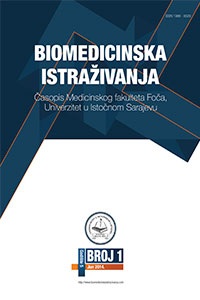Differentiation plasticity of human monocytes in culture
DOI:
https://doi.org/10.7251/BII2001001JAbstract
Introduction. Human monocytes are heterogeneous and plastic cell population
with the ability to undergo phenotypic and functional changes as
a response to a stimulus from a local microenvironment. Our aim was to
determine the potential of human monocytes to differentiate into different
cell populations depending on two different cytokines (IL-4 and IL-6)
added to cultures as well as to compare their phenotypical and functional
characteristics.
Methods. Peripheral blood mononuclear cells (PBMNC) were isolated from
buffy coats of healthy donors. Monocytes, which were separated from PBMNC
by plastic adherence, had been cultivated in Dendritic cell (DC), serum
free medium for 5 days, either with granulocyte/macrophage colony-stimulating
factor (GM-CSF) alone or with GM-CSF, with addition of interleukin
4 (IL-4) or interleukin 6 (IL-6), respectively. After cultivation, phenotypic
characteristics of these cells were analyzed by flow cytometry, whereas the
levels of produced cytokines in culture supernatants were quantified by
ELISA. The potential of differentiated cells to modulate the proliferation of
allogeneic T cells was examined by co-cultivation of these cells with PBMNC.
Results. GM-CSF differentiated monocytes into M0/M1 macrophages (MØ).
The combination of GM-CSF and IL-4 favoured differentiation of immature
DC, whereas GM-CSF and IL-6 transformed monocytes into monocytic myeloid
derived suppressor cells (M-MDSC). All cell populations expressed
typical monocyte/macrophage markers such as CD14, CD11b, CD16 and
CD33, HLA-DR, CD209 and CD86, a co-stimulatory marker. DC and M-MDSC
expressed CD1a and CD11c, in contrast to M0/M1 MØ. The expression
of HLA-DR, CD1a, CD209 and CD86 was highest on DC. The expression of
CD33 and CD16 was highest on M-MDSC, followed by lowest expression of
HLA-DR. The potential of promoting T-cell proliferation was highest in cultures
of PBMNC with DC, whereas M-MDSC had the opposite, suppressive,
effect. These differences correlated with highest production of immunosuppressive
cytokines such as IL-10, IL-27 and TGF-β by M-MDSC.
Conclusion. This study confirmed the differentiation plasticity of human
monocytes, which are influenced by cytokines added in cultures. Phenotypic
characteristics of these cells correlated with the production of cytokines
involved in modulation of T-cell proliferation.

